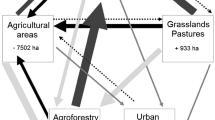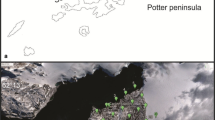Abstract
A comparative analysis has been performed on the informativity of characteristics of the state of lichen cover calculated by two methods for evaluating lichen abundance (frequency and projective cover). A close correlation of the indices obtained by the two different methods was shown, as well as their significant association with the degree of stress, which confirms their equal usefulness in lichenoindication works. However, comparison of the informativity established that the indices based on frequency have higher resolution capability.
Similar content being viewed by others
References
Ammann, K., Herzig, R., Liebendoerfer, L., and Urech, M., Multivariate correlation of deposition data of 8 different air pollutants to lichen data in a small town in Switzerland, in Advances in Aerobiology, Basel: Birkhäuser, 1987, pp. 401–406.
Asta, J., Erhardt, W., Feretti, M., et al., Mapping lichen diversity as an indicator of environmental quality, in Monitoring with Lichens–Monitoring Lichens, Nimis, P.L., Scheidegger, C., and Wolseley, P.A., Eds., Dordrecht: Kluwer, 2002. 273–279.
Byazrov, L.G., Epiphytic lichen sinusiae in birch forests within the Eastern Ural Radioactive Trace, in Ekologicheskie posledstviya radioaktivnogo zagryazneniya na Yuzhnom Urale (Ecologicl Consequences of Radioactive Contamination in the Southern Urals), Moscow: Nauka, 1993, pp. 134–155.
Byazrov, L.G., Lishainiki v ekologicheskom monitoringe (Lichens in Ecological Monitoring), Moscow: Nauchnyi Mir, 2002.
De Sloover, J. and LeBlanc, F., Mapping of atmospheric pollution on the basis of lichen sensitivity, Proc. Symp. Recent Advances in Tropical Ecology, Misra R. and Gopal, B., Eds., Varansi: Int. Soc. Tropical Ecology, 1968 pp. 42–56.
Gorshkov, V.V., Epiphytic lichen synusiae in pine forests of the Kola Peninsula: Formation, ecology, and influence of anthropogenic factors, Extended Abstract of Cand. Sci. (Biol) Dissertation, Leningrad, 1986.
Herzig, R. and Urech, M., Flechten als Bioindikatoren. Integriertes biologisches Messsystem der Luftverschmutzung für das Schweizer Mittelland, Bibl. Lichenol., 1991, vol. 43, pp. 43–1.
Kompleksnaya ekologicheskaya otsenka tekhnogennogo vozdeistviya na ekosistemy yuzhnoi taigi (Integrated Ecological Assessment of Technogenic Impact on Southern Taiga Ecosystems) Stepanov, A.M., Ed., Moscow: TsEPLb, 1992.
Kozlov, M.V., Zvereva, E.L., and Zverev, V.E., Impact of Point Polluters on Terrestrial Biota. Comparative Analysis of 18 Contaminated Areas, Dordrecht: Springer, 2009.
Leys, C. and Schumann, S., A nonparametric method to analyze interactions: The adjusted rank transform test, J. Exp. Soc. Psychol., 2010, vol. 46, no. 4, pp. 684–688.
Lichens, Bryophytes, and Air Quality, Nash, T. and Wirth, V., Eds., Bibliotheca Lichenologica, vol. 30, 1988.
Martin, L.N., Lichen indication mapping of the city of Tallinn, in Likhenoindkatsiya sostoyaniya okruzhayushchei sredy (Lichen Indication of the State of the Environment), Tallinn, 1978, pp. 134–139.
Mikhailova, I.N., Epiphytic lichen synusiae in forests of the Middle Urals under conditions of airborne industrial pollution, Extended Abstract of Cand. Sci. (Biol.) Dissertation, Yekaterinburg, 1996.
Mikhailova I.N. and Vorobeichik, E.L., Epiphytic lichenosynusiae under conditions of chemical pollution: Doseeffect dependencies, Russ. J. Ecol., 1995, vol. 26, no. 6, pp. 425–431.
Nimis, P.L., Castello, M., and Perotti, M., Lichens as biomonitors of sulphur dioxide pollution in La Spezia (Northern Italy), Lichenologist, 1990, vol. 22, pp. 22–333.
Paukov, A.G., The lichen flora of urban ecosystems, Extended Abstract of Cand. Sci. (Biol.) Dissertation, Yekaterinburg: Inst. Plant Anim. Ecol., Ural Branch, Russ. Acad. Sci., 2001.
Purvis, O.W., Chimonides, P.J., Jones, G.C., et al., Lichen biomonitoring near Karabash Smelter Town, Ural Mountains, Russia, one of the most polluted areas in the world, Proc. R. Soc. London B, 2004, vol. 271, no. 1536, pp. 221–226.
R Core Team, R: A Language and Environment for Statistical Computing, R Foundation for Statistical Computing, 2014. http://www.R-project.org/
Scheidegger, C. and Mikhailova, I., UmweltforschungFlechten als Bioindikatoren für die Luftverschmutzung im Ural: Eindrücke von einem gemeinsamen Forschungsprojekt, in Naturwerte in Ost und West. Forschen für eine nachhaltige Entwicklung vom Alpenbogen bis zum Ural, Landolt, R., Ed., Birmensdorf: Eidgenossische Forschungsanstalt WSL, 2000, pp. 55–59.
Smorkalov, I.A. and Vorobeichik, E.L., Soil respiration of forest ecosystems in gradients of environmental pollution by emissions from copper smelters, Russ. J. Ecol., 2011, vol. 42, no. 6, pp. 429–435.
Smorkalov, I.A. and Vorobeichik, E.L., The impact of a large industrial city on the soil respiration in forest ecosystems, Euras. Soil Sci., 2015, vol. 48, no. 1, pp. 106–114.
Tarasova, V.N., Epiphytic lichen cover in basic types of pine forests and its formation in Southern Karelia, Cand. Sci. (Biol.) Dissertation, St. Petersburg: Bot. Inst. im. V.L. Komarova, Russ. Acad. Sci., 2000.
Trass, H.H., Analysis of the lichen flora of Estonia, Extended Absrtract of Doctoral (Biol.) Dissertation, Leningrad: Bot. Inst. USSR Acad. Sci., 1968.
Vorobeichik, E.L., Marin, Yu.F., Zhigalsky, O.A., et al., Prospects for using the Visim Nature Reserve in studies on anthropogenic effects on terrestrial ecosystems, in Problemy zapovednogo dela (Problems in management of Specially Protected Areas), Yekaterinburg, 1996, pp. 19–23.
Zolotarev, M.P. and Bel’skaya, E.A., The fauna of herpetobiont invertebrates in a large industrial city: Discrimination between the effects of recreation and urbanization, Sib. Ekol. Zh., 2015, no. 1, pp. 1–102.
Author information
Authors and Affiliations
Corresponding author
Additional information
Original Russian Text © I.N. Mikhailova, V.S. Mikryukov, I.V. Frolov, 2015, published in Ekologiya, 2015, No. 6, pp. 427–433.
Rights and permissions
About this article
Cite this article
Mikhailova, I.N., Mikryukov, V.S. & Frolov, I.V. State of epiphytic lichen communities under anthropogenic impact: Effect of abundance assessment methods on the informativity of indices. Russ J Ecol 46, 531–536 (2015). https://doi.org/10.1134/S1067413615060119
Received:
Published:
Issue Date:
DOI: https://doi.org/10.1134/S1067413615060119




